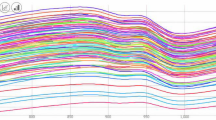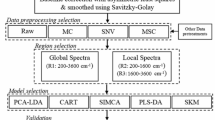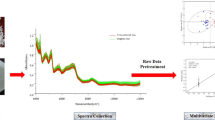Abstract
One of the most important problems associated with the rice industry is the authenticity, mainly the identification of varieties by providing a reliable, fast, yet accurate method. To overcome these limitations, the development of fast and non-destructive methodologies for different rice type classification is, nowadays, a huge challenge for producers. The near-infrared (NIR) spectroscopy associated to principal component analysis (PCA), partial least squares-discriminant analysis (PLS-DA), and support vector machines (SVM) for discrimination and classification of rice varieties (Indica and Japonica) were explored after different spectra processing steps such as multiplicative scatter correction (MSC), first derivative and second derivative. The SVM model developed after the MSC processing procedure, showed a significant fitting accuracy (97%), cross-validation (93%) and prediction (91%). These data support the robustness of the model for efficient rice types classification. In terms of spectral analysis, the major differences between both rice types are present at range 7476–7095 cm−1, 7046 cm−1 and 4264–4153 cm−1, which can be used for its discrimination. This study showed that NIR spectroscopy associated to PLS-DA and SVM techniques allowed an efficient discrimination of rice samples, being considered as a suitable strategy for a competent system for fully automated classification and sorting of rice types grouping with a high level of accuracy, representing a valuable approach for discrimination and anti-fraud procedure for food control as well as in terms of security issues of any product.






Similar content being viewed by others
References
Kong X, Zhu P, Sui Z, Bao J (2015) Physicochemical properties of starches from diverse rice cultivars varying in apparent amylose content and gelatinization temperature combinations. Food Chem 172:433–440
Masuda N, Tsujinaka H, Hirai H, Yamashita M, Ueda T, Ogata N ((2003) ) Mapping of quantitative trait loci controlling physico-chemical properties of rice grain (Oryza sativa L.). Breed Sci 53(1):(1):209–215–215. https://doi.org/10.1186/s12886-019-1076-3
Xie L, Chen N, Duan B, Zhu Z, Liao X (2008) Impact of proteins on pasting and cooking properties of waxy and non-waxy rice. J Cereal Sci 47:372–379
Champagne ET, Bett KL, Vinyard BT, Webb BD, McClung AM, Barton FE (1997) Effects of drying conditions, final moisture content and degree of milling on rice flavor. J Cereal Chem 74:566–570
Champagne ET, Lyon BG, Min BK, Vinyard BT, Bett KL, BartonFE WBD, McClung AM, Moldenhauer KA, Linscombe S, Kohlwey MKS (1998) Effects of postharvest processing on rice texture profile analysis. J Cereal Chem 75:181–186
Kraehmer H, Thomas C, Vidotto F (2017) Rice production in Europe. In: Chauhan B, Jabran K, Mahajan G (eds) Rice production worldwide. Springer, Cham, pp 93–116
Lu BR, Cai X, Xin J (2009) Efficient Indica and Japonica rice identification based on the InDel molecular method: Its implication in rice breeding and evolutionary research. Prog Nat Sci 19(10):1241–1252
Kong W, Zhang C, Liu F, Nie P, He Y (2013) Rice seed cultivar identification using near-infrared hyperspectral imaging and multivariate data analysis. Sensors 13:8916–8927
Lin L, He Y, Xiao Z, Zhao K, Dong T, Nie P (2019) Article rapid-detection sensor for rice grain moisture based on NIR spectroscopy. Appl Sci 9:1654–1667
Wehling RL (1998) Infrared spectroscopy. In: Nielson SS (ed) Food analysis, chapter 27, 2nd edn. Aspen Publishers, Inc., Gaithersburg, pp 413–424
Ma H, Wang J, Chen Y, Cheng J, Lai Z (2017) Rapid authentication of starch adulteration in ultrafine granular powder of Shanyao by near-infrared spectroscopy coupled with chemometric methods. Food Chem 215:108–115
Sampaio PN, Castanho A, Almeida AS, Oliveira J, Brites C (2018) Optimization of rice amylose determination by NIR-spectroscopy using PLS chemometrics algorithms. Food Chem 242:196–204
Jolliffe IT (2002) Principal component analysis, 2nd edn. Springer, Cham
Ballabio D, Consonni V (2013) Classification tools in chemistry. Part 1: linear models PLS-DA. Anal Methods 5:3790–3798
Barker M, Rayens W (2003) Partial least squares for discrimination. J Chemom 17:166–173
Scott SM, James D, Ali Z (2006) Data analysis for electronic nose systems. Microchim Acta 156:183–207
Brereton RG (2009) Chemometrics for pattern recognition. Wiley, Chichester
Rodríguez N, Ortiz MC, Sarabia L, Gredilla E (2010) Analysis of protein chromatographic profiles joint to partial least squares to detect adulterations in milk mixtures and cheeses. Talanta 81:255–264
Spring ML (2008) Support vector machines, vol 1. Springer, New York
Balabin RM, Safieva RZ, Lomakina EI (2011) Near-infrared (NIR) spectroscopy for motor oil classification: from discriminant analysis to support vector machines. Microchem J 98:121–128
Santos PM, Pereira-Filho ER, Rodriguez-Saona LE (2013) Rapid detection and quantification of milk adulteration using infrared microspectroscopy and chemometrics analysis. Food Chem 138:19–24
ISO 6647–2:(2015) Rice—Determination of amylose content—Part 2: Routine method
Ferreira AR, Oliveira J, Pathania S, Almeida AS, Brites C (2017) Rice quality profiling to classify germplasm in breeding programs. J Cereal Sci 76:17–27
Martens H, Naes T (1989) Multivariate calibration. Wiley, Chichester
Naes T, Isaksson T, Fearn T, Davies T (2004) A user-friendly guide to multivariate calibration and classification. NIR Publications, Chichester
Savitzky A, Golay MJE (1964) Smoothing and differentiation of data by simplified least squares procedures. Anal Chem 36:1627–1638
Naes T, Isaksson T, Kowalski BR (1990) Locally weighted regression and scatter correction for near-infrared reflectance data. Anal Chem 62:664–673
Teye E, Amuah C, McGrath T, Elliot C (2019) Innovative and rapid analysis for rice authenticity using hand-held NIR spectroscopy and chemometrics. Spectrochim Acta A Mol Biomol Spectrosc 217:147–154
Kuang Q, Xu J, Wang K, Zhou S, Liux X (2016) Structure and digestion of hybrid Indica rice starch and its biosynthesis. Int J Biol Macromol 93:402–407
Chen H, Tan C, Lin Z (2018) Int J Anal Chem 2018:8 (Article ID 8032831)
Osborne BG, Mertens B, Thompson M, Fearn T (1993) The authentication of Basmati rice using near infrared spectroscopy. J Near Infrared Spectrosc 1:77–83
Chen J, Miao Y, Sato S, Zhang H (2008) Near-infrared spectroscopy for determination of the protein composition of rice flour. Food Sci Technol Res 14:132–138
Xie F, Dowell F, Sun X (2004) Using visible and near-infrared reflectance spectroscopy and differential scanning calorimetry to study starch, protein, and temperature effects on bread staling. Cereal Chem 81:249–254
Cho SY, Choi SG, Rhee C (1998) Determination of degree of retrogradation of cooked rice by near-infrared reflectance spectroscopy. J Near Infrared Spectrosc 6:355–359
Barton FE, Himmelsbach DS, McClung AM, Champagne EL (2002) Two-dimensional vibration spectroscopy of rice quality and cooking. Cereal Chem 79:143–147
Franca AS, Nollet LML (2017) Spectroscopic methods in food analysis. CRC Press, Boca Raton
Chen J, Li M, Pan T, Pang L, Yao L, Zhang J (2019) Rapid and non-destructive analysis for the identification of multigrain rice seeds with near-infrared spectroscopy. Spectrochim Acta A Mol Biomol Spectrosc 219:179–185. https://doi.org/10.1016/j.saa.2019.03.105
Bagchi T, Sharma S, Chattopadhyay K (2016) Development of NIRS models to predict protein and amylose content of brown rice and proximate compositions of rice bran. Food Chem 191:21–27
Fertig C, Podczeck F, Jee R, Smith M (2004) Feasibility study for the rapid determination of the amylose content in starch by near-infrared spectroscopy. Eur J Pharm Sci 21:155–159
Vichasilp C, Kawano S (2015) Prediction of starch content in meatballs using near infrared spectroscopy (NIRS). Int Food Res J 22:1501–1506
Wong KH, Razmovski-Naumovski V, Li KM, Li GQ, Chan K (2015) The quality control of two Pueraria species using Raman spectroscopy coupled with partial least squares analysis. J Raman Spectrosc 46:361–368
Hirri A, Bassbasi M, Platikanov M, Tauler R, Oussama A (2016) FTIR Spectroscopy and PLS-DA classification and prediction of four commercial grade virgin olive oils from Morocco. Food Anal Methods 9:974–981
Lin W-S, Yang C-M, Kuo B-J (2012) Classifying cultivars of rice (Oryza sativa L.) based on corrected canopy reflectance spectra data using the orthogonal projections to latent structures (O-PLS) method. Chemom Intell Lab Syst 115:25–36
Xie C, Wang Q, He Y (2014) Identification of different varieties of sesame oil using Near-Infrared hyperspectral imaging and chemometrics algorithms. PLoS ONE 9(5):e98522
Yang X, Hong H, You Z, Cheng F (2015) Spectral and image integrated analysis of hyperspectral data for waxy corn seed variety classification. Sensors 15:15578–15594
Uarrota V, Moresco R, Coelho B, Nunes E, Peruch L, Neubert E, Rocha M, Maraschin M (2014) Metabolomics combined with chemometric tools (PCA, HCA, PLS-DA and SVM) for screening cassava (Manihot esculenta Crantz) roots during postharvest physiological deterioration. Food Chem 161:67–78
Zareiforoush H, Minaei S, Alizadeh MR, Banakar A (2016) Qualitative classification of milled rice grains using computer vision and metaheuristic techniques. J Food Sci Technol 53:118–131
Acknowledgements
Funding for this research has been received from the Portuguese Fundação para a Ciência e Tecnologia (FCT) under the grant agreement number RECI/AGR-TEC/0285/2012, BEST-RICE-4-LIFE project and P.N. Sampaio acknowledges the financial support of Post-Doc research Grant included in this project. A. Castanho acknowledges the financial support from the FCT PhD grant SFRH/BD/120929/2016.
Author information
Authors and Affiliations
Corresponding author
Ethics declarations
Conflict of interest
The authors (Pedro N. Sampaio, Ana Castanho, Ana Sofia Almeida, Jorge Oliveira and Carla Brites) declare that they do not have any relationship or interest with other people, organisations or financial entities that could inappropriately influence and that prevent the disclosure and publication of the experimental results of this work.
Ethical approval
This article does not contain any studies with human participants or animal performed by any of the authors.
Informed consent
Not applicable.
Additional information
Publisher's Note
Springer Nature remains neutral with regard to jurisdictional claims in published maps and institutional affiliations.
Rights and permissions
About this article
Cite this article
Sampaio, P.S., Castanho, A., Almeida, A.S. et al. Identification of rice flour types with near-infrared spectroscopy associated with PLS-DA and SVM methods. Eur Food Res Technol 246, 527–537 (2020). https://doi.org/10.1007/s00217-019-03419-5
Received:
Revised:
Accepted:
Published:
Issue Date:
DOI: https://doi.org/10.1007/s00217-019-03419-5




